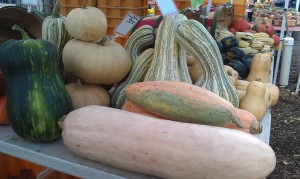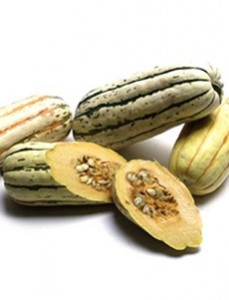 During the spring and summer, a lot of the produce at the farmers market is familiar: fresh tomatoes, bright yellow ears of sweet local corn and bell peppers so large they’re nearly unidentifiable.
During the spring and summer, a lot of the produce at the farmers market is familiar: fresh tomatoes, bright yellow ears of sweet local corn and bell peppers so large they’re nearly unidentifiable.
When autumn rolls around, it’s not hard to spot familiar apples and pumpkins, but you might find yourself overwhelmed with the variety of squash that suddenly fills the produce stands.
To keep you from falling victim to any winter squash conundrums, we’ve pulled together a guide of some of the most common, and some of the lesser known, types of winter squash you might come across this season.
Acorn Squash: Easily found in grocery stores and at farm stands year-round, this winter squash is small and, like its namesake, shaped like an acorn. While many people enjoy simply slicing it in half and adding butter or margarine and brown sugar for additional flavor, you can amp its nutritional value by serving it in an elegant salad, like our roasted acorn squash, pomegranate and arugula salad. Acorn squash has a number of health benefits and may help prevent cancer, lung disease and some cardiovascular conditions.
Banana Squash: Unlike its namesake, this squash grows up to two feet long and six inches in diameter. It has sweet, bright orange flesh similar to that of the more widely recognized butternut squash. While some farms and markets will sell it whole, it’s more often sold peeled and cubed in small pieces for ease of use. Use banana squash in place of butternut in your favorite butternut squash soup recipe or serve it roasted with a touch of olive oil, salt, pepper and your favorite spices.
Butternut Squash: Easily found in supermarkets during most of the year, this bell-shaped squash peaks from late summer to early fall. Versatile enough for sweet and savory dishes, there are a lot of ways to prepare butternut squash in soups, stews, salads or baked goods. Butternut squash is high in fiber, vitamin A and a potassium, which helps bone health.
Carnival Squash: Brightly colored with orange and green spots and stripes, carnival squash resembles the ubiquitous acorn squash, but has yellow flesh similar to sweet potatoes or butternut squash. Carnival squash can be blended into your favorite soup or stew, but is also delicious baked or steamed with a moderate amount of butter or margarine and your favorite herbs or spices. Carnival squash, like many squash varieties, can help lower blood sugar and is high in vitamin A and beta-carotene.
Delicata Squash: Shaped like a peanut, this variety is also referred to as “bohemian squash” and is known to be one of the more flavorful winter squashes. With a creamy fresh reminiscent of sweet potatoes, delicata squash range from five to 10 inches in length and are best baked or steamed.
Spaghetti Squash: Yellow-skinned and watermelon-shaped, spaghetti squash has a nutty flavor and flesh that separates into long strands that resemble spaghetti. Spaghetti squash is low in calories, high in fiber and perfect for dieters who want to swap squash for high-calorie pasta. Try spaghetti squash in spaghetti squash parmesan or simple spaghetti squash with marinara sauce.

